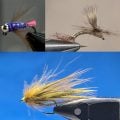How to Tie Gary LaFontaine’s Buzzball
Producer: Tim Flagler
This is Gary LaFontaine’s Buzzball. It’s meant to imitate a midge cluster, in other words, a bunch of midges kind of smushed together in a group, floating on the water’s surface. For winter midge hatches, it’s hard to beat. Although most people tie it a bit larger than this, say 16’s and 18’s, I’m going to tie it in a size 20, as our midges here in New Jersey tend to be really small.
So, for a hook, I’m going to use a Lightning Strike DF3 dry fly hook in size 20. Begin by getting the hook firmly secured in the jaws of your tying vise.
For thread, I load a bobbin with a spool of black Veevus 16/0. It’s super thin so it doesn’t build up bulk, but is still quite strong. Get the thread started on the hook shank behind the eye and, after taking a few wraps rearward, snip off the excess tag.
The first of only two materials to be tied in is a grizzly hackle feather, from either a saddle or, as shown here, a cape. You want the feather to have some length because it needs to be wrapped all the way up the shank. For this size 20 hook, I’m going to use one with barbules that measure out to 18, but going a little larger or smaller is ok. Once I’m sure the feather’s of the correct size, I’ll pull it free from the skin.
To prep the feather for tie-in, hold it with the dull or back side facing you. This makes the stem more visible. You want to cut off the lower, thicker portion of the stem then strip about 1/4” of fibers from both sides. Now, flip the feather over so the shiny or front side is facing you. From the top side of the stem only, strip another 1/8” or so of fibers. Doing this will help the first wrap of the feather orient correctly, with the shiny side facing forward.
Bind the bare part of the stem to the near side of the hook with tight wraps of tying thread, so the hackle fibers will begin right at the start of the hook bend. Once the feather’s bound down well, relocate your tying thread forward to the initial tie-in point.
Although Buzzballs can be tied in a variety of colors, orange is the most traditional. So, here I’m going to use a single orange grizzly feather from a Whiting Farms bugger pack. The size of the fibers on the feather doesn’t matter much, but do make sure it’s fairly long, as here too you’ll be wrapping it over the entire length of the hook shank. As you did before, with the dull or back side of the feather facing you, snip or strip off the thicker, lower part of the stem. Then, after flipping the feather over so the shiny side faces you, strip off 1/8” of fibers from just the top side of the stem. Once again, that little extra bit of bare stem should help the feather to wrap correctly.
Tie in the feather’s stem against the near side of the hook, just as you did with the grizzly hackle feather. When you reach the hook bend, return your tying thread forward to behind the hook eye. Grab your favorite hackle pliers and use them to get hold of the orange feather’s very tip. If the feather wants to give you trouble on the first wrap, just try coming at it from a different angle. You really want the stripped side of the stem to contact the hook shank first, so the feather wraps with the shiny side facing forward. Keep taking touching wraps, up the hook shank, until you reach your tying thread. Use the thread to anchor the feather’s tip then sweep all the fibers rearward to clear the eye. You can then snip the excess tip off close and get rid of any wayward fibers.
To me, the real trick with this fly is to, at this point, get hold of your whip finish tool, and do a 4 or 5 turn whip finish, seat the knot well and snip or cut your tying thread free. This allows you to trim the orange hackle fibers to slightly less than a hook gap in length, without fear of snipping your tying thread. Once the fibers have been trimmed short all around, simply reattach your tying thread behind the hook eye.
Now get hold of the tip of the grizzly hackle feather and start taking touching wraps with it through the snipped-off orange hackle. Just behind the hook eye, anchor the feather’s tip with wraps of tying thread. Sweep everything back, take a few more thread wraps then snip the excess tip off close, as well as any errant fibers. Do a 4 or 5 turn whip finish, seat the knot well and snip or cut your tying thread free.
To get the Buzzball to ride correctly on the water’s surface, snip a “V” out of both the top and bottom. You’re really only snipping grizzly fibers at this point.
The finished fly should look something like this. I’ve always thought of the Buzzball as a winter pattern but I’ve heard of quite a few people using it with success year round.
How to Tie Gary Kreb's Foam Baitfish
How to Tie Higa's Olive SOS











